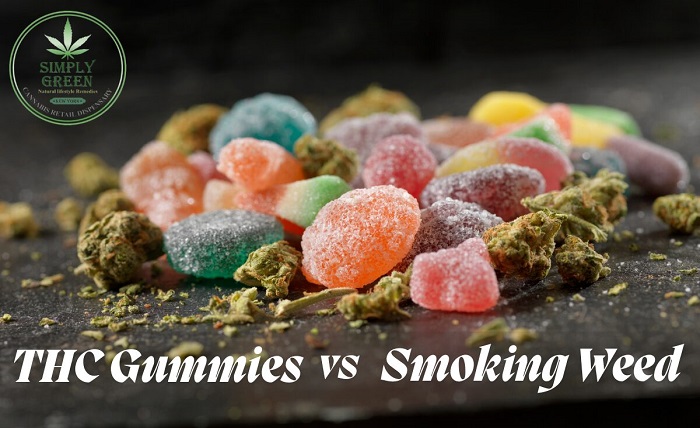As cannabis use becomes more mainstream, people are exploring new ways to consume it beyond the traditional smoking method. One of the most popular alternatives is weed gummies, a discreet and tasty edible that delivers the effects of cannabis without the smoke. But when it comes to health, convenience, and overall experience, which option is better: weed gummies or smoking? Let’s break down the key differences to help you decide.
Onset of Effects: Fast vs. Delayed
One of the biggest differences between smoking and weed gummies is how quickly you feel the effects.
- Smoking cannabis delivers THC directly to the lungs, where it enters the bloodstream almost immediately. Within minutes, most users feel the psychoactive “high.” This fast onset makes smoking appealing to those who want quick results, whether for relaxation, stress relief, or recreational enjoyment.
- Weed gummies, on the other hand, take longer to kick in. Since they need to be digested, the THC passes through the stomach and liver before reaching the bloodstream. The process can take anywhere from 30 minutes to two hours, depending on metabolism and whether you’ve eaten beforehand. For beginners, this delayed onset can be tricky because it’s tempting to eat more before the first dose fully takes effect.
Duration of Effects: Short vs. Long-Lasting
While smoking provides quick effects, they fade relatively fast. The high usually lasts 1–3 hours, depending on the amount consumed and the individual’s tolerance.
By contrast, weed gummies deliver a much longer experience. Once the THC is processed through the digestive system, the effects can last 4–8 hours or even longer. For medical users seeking sustained pain relief or those who want a longer-lasting recreational high, edibles may be the better choice.
Health Considerations: Lungs vs. Digestion
Health is one of the main reasons many people switch from smoking to edibles.
- Smoking cannabis exposes the lungs to tar, carcinogens, and other harmful byproducts of combustion, similar to smoking tobacco. While cannabis smoke is not identical to cigarette smoke, frequent inhalation may still irritate the lungs and lead to coughing, phlegm buildup, or bronchitis-like symptoms.
- Weed gummies eliminate the risk of inhaling smoke altogether. Since they are eaten, they bypass the lungs, making them a safer option for respiratory health. However, edibles may pose risks for digestion if consumed in large amounts, particularly for individuals with sensitive stomachs. Additionally, because the effects last longer, it’s easier to overconsume, which can lead to unpleasant experiences like paranoia, anxiety, or nausea.
Dosing and Control: Easy to Measure vs. Guesswork
Another important difference lies in dosing.
- Smoking makes it harder to measure exactly how much THC you’re consuming. The strength of cannabis flower can vary, and inhalation depends on puff size, duration, and personal tolerance. This inconsistency can make it difficult for beginners to control their experience.
- Weed gummies offer more precise dosing. Each gummy typically contains a clearly labeled amount of THC or CBD, allowing users to measure their intake accurately. This makes edibles especially appealing to medical cannabis patients who need consistency for managing symptoms.
Convenience and Discretion
Both methods have their own level of convenience, but weed gummies often come out ahead when it comes to discretion.
- Smoking produces a strong smell, requires rolling papers, pipes, or vaporizers, and can’t easily be done in public without drawing attention.
- Weed gummies are easy to carry, odorless, and can be consumed like candy. This makes them far more discreet, particularly for those who want to use cannabis in social settings or while traveling.
Cost and Availability
In terms of cost, both options can vary depending on where you live and the quality of the product. Smoking cannabis might be cheaper per use if you purchase flower in bulk, but you’ll also need accessories like pipes, lighters, or rolling papers.
Weed gummies are often sold at higher prices due to the manufacturing process, but many consumers find the longer-lasting effects make them more cost-efficient in the long run.
Risks of Overconsumption
It’s worth noting that both methods carry risks if used irresponsibly.
- With smoking, the primary concern is long-term lung health.
- With weed gummies, the risk lies in overconsumption. Because edibles take longer to kick in, many people eat more than intended, leading to stronger and sometimes overwhelming effects. While not physically dangerous, this can result in anxiety, panic, or an uncomfortable experience that lasts hours.
The best way to avoid this is by starting with a low dose (such as 5 mg of THC) and waiting at least two hours before considering more.
Which Is Better for You?
Ultimately, the choice between smoking and weed gummies depends on your priorities:
- If you want fast-acting effects and enjoy the ritual of smoking, then smoking may suit you better.
- If you prefer long-lasting relief, precise dosing, and avoiding harm to your lungs, then weed gummies are likely the healthier and more convenient option.
For many, the ideal approach might be a mix of both—smoking when immediate relief is needed, and edibles for sustained effects.
Final Thoughts
Cannabis offers different experiences depending on how you consume it. While smoking provides quick results, weed gummies stand out as a safer, longer-lasting, and more discreet option. The best choice comes down to your personal lifestyle, health considerations, and how you want to experience cannabis. As with any form of cannabis, moderation and responsible use are key to ensuring a positive outcome.
